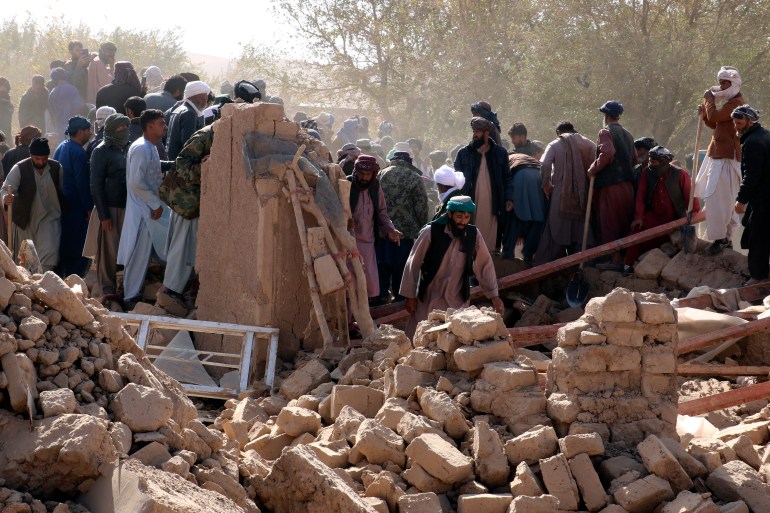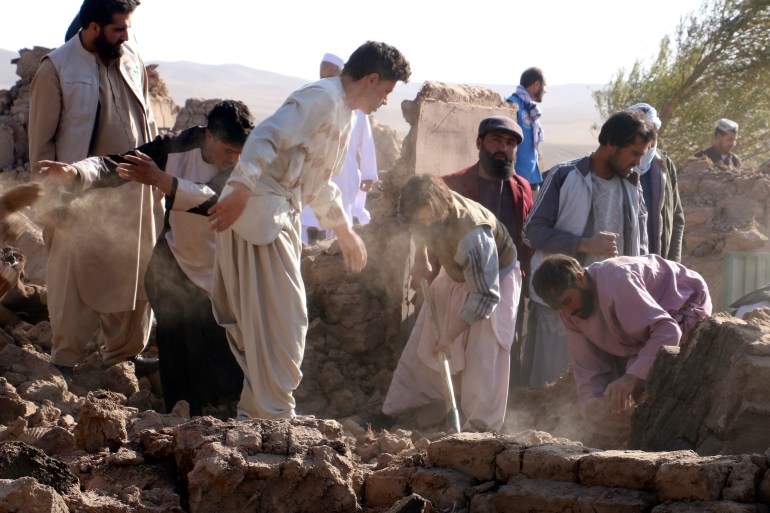Volunteers and rescue staff in quake-hit Afghanistan say they’re compelled to make use of shovels and even their naked arms to search for victims and survivors.
“There isn’t any fashionable gear nor educated search and rescue groups. This might end in an increase in casualties. If we don’t urgently obtain superior and educated rescue groups within the space quickly, we are going to see a rise within the lack of lives that might have been prevented,” Sabir, a rescue employee in western Afghanistan’s Herat province, instructed Al Jazeera on Sunday.
He urged the worldwide neighborhood to ship rescue groups to the impoverished South Asian nation, which lacks a sturdy catastrophe administration company and different assets because the Taliban regained energy two years in the past.
In keeping with official figures, no less than 2,053 individuals have been killed and almost 10,000 injured after the magnitude 6.3 quake and a number of other aftershocks hit the aid-dependent nation on Saturday morning.
Sabir mentioned the precise toll may very well be increased.
“We nonetheless don’t find out about casualties as a result of most individuals – useless or alive – are nonetheless buried beneath the particles,” he mentioned, including that it was laborious to place a quantity on what number of are nonetheless trapped.
Sabir mentioned he was jolted awake when the highly effective earthquake shook the ground. “It was in contrast to something I had skilled earlier than,” the 30-year-old instructed Al Jazeera by phone
“It was an enormous vibration, and I felt worry, anxiousness and panic altogether,” he mentioned.
Shortly after making certain his household’s security, Sabir, an help employee with an area NGO, reported to work to assist with the emergency response.
It was solely after arriving within the Zenda Jan district of Herat, the quake’s epicentre, that he witnessed the extent of the influence of the tragedy. No less than 13 villages on this district alone had been deeply affected, he mentioned.
“The scenes I witnessed are among the most horrible issues I’ve seen in my life,” Sabir instructed Al Jazeera, including that villages with greater than 400 households had been changed into ruins.
“No less than 9 villages within the district had been utterly razed with no buildings left standing,” he mentioned. “There have been youngsters, girls and the aged among the many our bodies that had been being pulled out.”

Lack of assets, rescuers
Sabir mentioned there was an pressing want for meals, water and shelter, particularly for ladies and kids who misplaced their properties.
“There’s a scarcity of water and meals, and households, girls and kids, don’t have any shelter or tents to guard them from the climate and chilly night time,” he mentioned, including that volunteers introduced in some assets, however they weren’t ample.
“A number of volunteers from Herat metropolis travelled to those websites, which was very helpful and helped save lives, however there may be much more that’s nonetheless wanted,” he mentioned.
Sabir mentioned aside from meals, water and tents, the survivors additionally want medical and psychosocial assist.
“One requirement particularly is the care of many youngsters who had been orphaned or are separated from their households. They want psychosocial assist, somebody to maintain them,” he mentioned.
Nevertheless, a major discount in overseas funds because the Taliban takeover in 2021 has left aid-dependent Afghanistan susceptible to humanitarian crises. Additionally, there may be additionally a dearth of expert staff as a result of many Afghans with experience fled the nation after the Taliban regained energy.
Native officers and residents mentioned they’re struggling to conduct search and rescue operations.
“The disaster is already out of the capability of the native authorities in Herat. It wants a extra concentrated response, and there’s a want for contemporary rescue gear, which we don’t have,” mentioned Abdul Baset Rahmani, a catastrophe administration professional who has joined the volunteers in Herat.

Regardless of mounting challenges, rescuers and volunteers stay hopeful of saving extra lives.
“This village has a inhabitants of almost 2,000. We solely discovered 40 individuals. The remainder are nonetheless buried. A lot of them are alive,” Sabir mentioned as he helped the rescue work in Herat’s Naib Rafi village.
He mentioned he walked previous every pile of rubble that was once a home and known as out to anybody who may reply.
“I stored calling, ‘Is anybody there?’ after which we heard a voice. ‘Sure, I’m alive,’” he mentioned. Sabir and his colleagues rapidly helped dig a person out alive – the only survivor in his household.
“It was probably the most distressing second of my life,” Sabir mentioned.
